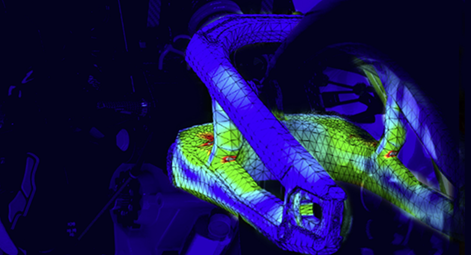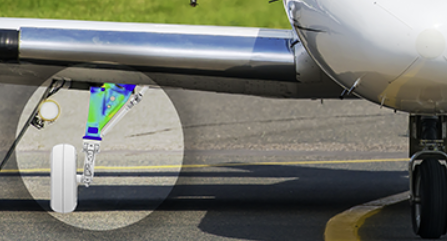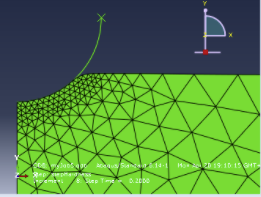
Whether you’re venturing into FEA for the first time or you’re a seasoned analyst, it is important to have a good picture in your mind – and maybe even a written plan – for your model before you ever even open the pre-processing software. If you try to skip this step, you’ll likely be heading for disaster – or at least questionable results and a lot of time wasted fixing things and iterating.
Here, we’ve laid out the eight things that we think should be considered prior to building an FEA model:
1) The Problem Definition
Before you dive in and start meshing, it’s really important to have a clear picture of the problem and how you intend to tackle it. A great example of this might be if you’re modeling an axle assembly:
- Do you need the whole vehicle in the model?
- If not, how will you represent the rest of the vehicle?
- What is the loading like? Driving along the regular road or hitting a pothole (Michigan)?
- What are you trying to understand – the overall stiffness, fatigue life, etc.?
- Who will you be presenting the results to, and what do they care about seeing?
Answering these questions before getting started will allow you to make the most informed decisions when we get to points 2 thru 8.
2) The Type Of Analysis You’ll Employ
We can do a whole lot with modern FEA codes including, but not limited to, structural (static or dynamic), thermal (steady-state or transient), acoustic, electrical, and all sorts of combinations of these in multiphysics analyses. The question we must answer before beginning our model build is – which one of these analysis types is most appropriate?

A great example here would be modeling automotive crashworthiness. We know that this problem is likely to require understanding of inertia, so it is unlikely that a static analysis would cut it. On the other hand, if we’re modeling the steady-state thermo-mechanical effects of battery heating, we likely don’t want to use Abaqus explicit.
Having a good grasp of the physics that you’ll need to simulate is essential, because, not only does it dictate the type of solver you will use, it also drives many of the decisions that we’ll cover next.
3) Which Parts You’ll Actually Need – And How You’ll Represent Them
Being an FEA analyst is all about compromise. As we alluded to in the first point, it is unlikely that, when modeling an axle assembly, we’d include the entire vehicle. To that end, it is also likely that the CAD we receive from the designers will have all sorts of components that we don’t want/need to include in our model – think screws, nuts, bolts, washers etc. Deciding which parts are necessary and parsing the model down appropriately should be done prior to any model building. This means we can avoid any extra work building and then removing components later in the process.

It is not only parsing that is important here, but also planning how we want to discretize the components. Oftentimes, we’ll encounter situations where components take the form of shells (thin walls) or beams (rods, bars etc.) while others must be represented in full 3D fidelity. Having a strong understanding and picture of the types of elements you might use before you go ahead and mesh everything in 3D will save you both time and stress (get it?) because you’ll be able to set the model up correctly first time. There’s nothing worse than meshing a thin sheet with appropriately fine 3D elements only to find that your final model has 10,000,000+ nodes in it!
4) Materials
The materials in an FEA model are just as important as the geometry itself. And the level of detail you need to include in your material models should be carefully thought through before you start building. If you’re just assessing stiffness of a steel structure, or you’re looking for a 5x safety factor on yield, then it’s likely that a purely linear material model will suffice. However, what about when you’re running that same structure to failure? Well now it’s likely that you’ll need to consider material plasticity and maybe even some damage initiation and evolution. Is this happening dynamically? Then what about strain rate dependence? The question that you’re using FEA to answer will dictate your material definition.
Beyond just metal plasticity, there are a whole host of other materials that Abaqus (and many other commercial FEA codes) can deal with. Rubbers and foams, for example, deform in very different ways than metals and, as such, might require us to define hyperelastic or hyperfoam material models. And we’ve not even mentioned the properties that you’ll need to include when performing thermal, electrical or acoustic analyses…
5) How Your Components Will Interact With Each Other
This is often one of the trickiest concepts for a new analyst to fathom. There are many ways to have components interact with each other, but it is essential that you consider the results you’re looking for before you make your selection.
In the most basic of structural FEA analyses, parts can simply be tied (or glued) together. Tied surfaces essentially move in unison. Although not a particularly good representation of the real world when applied blindly, this can be a great way to build models when looking for baseline results or, with a little extra care, when you’re modeling welds. From there, we move up in complexity to couplings (kinematic and distributing), where you might be representing bolts or other non-modeled features and fasteners. If none of these simplifications are acceptable, we can utilize full contact modeling in which parts can come in and out of contact, slide with or without friction and transmit heat, electric or sound dependent upon contact pressure.
Imagine you’re trying to predict the stick-slip behavior of a connection… you certainly wouldn’t be able to tie the surfaces together and get the results you’re looking for. Equally, when analyzing a large platform structure, it’s unlikely that you’d want to model every single bolted connection with the utmost detail including bolts, contact and preloads. It’s always best to look for opportunities to simplify where possible – and build in complexity as and when you need to.
6) How You’ll Apply Loading And Boundary Conditions
There are many different ways to load and constrain a finite element model – none are correct or incorrect, but it is important that you have a good understanding of the effects of each method. For example, fixing the base of a compression block in all degrees of freedom will prevent its section from changing due to Poisson’s ratio – essentially rendering the boundary like a sticky surface. However, if we were only to prevent motion in the direction of load application, change in shape of the block would be allowed at the base and the results would be wildly different with what might seem (to the untrained eye) like an equivalent boundary. Going back to our first point, having a really good grasp of the problem definition, the things that are important in your analysis and an ability to visualize what boundary conditions and loading will look like should set you in good stead to build robust and accurate FEA models.
7) Where Your Results Will Matter – And Where You Can Get Away With A Coarser Mesh
Specifically related to meshing, it’s always a good idea to know where you’ll be needing really accurate output and where you might be able to get away with coarser mesh. Typically, this might look like filets, interactions, etc. On the other hand, it’s not likely that you’ll be concerned too much by stresses in the core of a component or on a face that is constrained. If you need four elements at a filet for example – in order to extract accurate stresses for a subsequent fatigue analysis – you’re likely to be utilizing a very fine mesh of the order of millimeters. However, if you employ that meshing strategy everywhere in your model, you’ll quickly rack up a whole lot of nodes and elements, which renders your model very expensive and highly inefficient.

Have a picture in your mind of where you need accuracy and where it can be sacrificed prior to getting started and you’ll start to prepare much more accurate and efficient FEA models because of it!
8) What Results You’ll Want To Output
We’ve all come across an FEA results file in the 10’s of gigabytes before, but it doesn’t have to be that way. Instead of selecting all the default outputs that the pre-processor suggests, you should take some time to decide what you actually need out of your analysis. This can help significantly reduce output database size, saving space on your hard drive and time to open and manipulate the data in your post-processor.
Another huge time-saver, that people often think about only once their 2-day long analysis has completed, is what history data they might need. This is data that can be written out in tabular form and saved in the Abaqus data (.dat) file and it can include things like stresses, strains, displacements and forces at certain nodes/elements of interest as well as information on contact behavior and all sorts of other things that we probably don’t want to manually extract from the model after the fact.
Having a good idea of the information that we need to pull out of our model before we run it can result in enormous savings of both time and space.
Final thoughts
This post is aimed at highlighting some of the things that you might want to think about before you start clicking away and building your finite element model. Hopefully, some of this will resonate and maybe help you with your FEA model building in the future. Treat this as a checklist and you’ll be building models with the best of them in not time at all!
If you’d like more help with building FEA models, or any other type of simulation, get in touch with the experts at Fidelis! We’re here to help!
